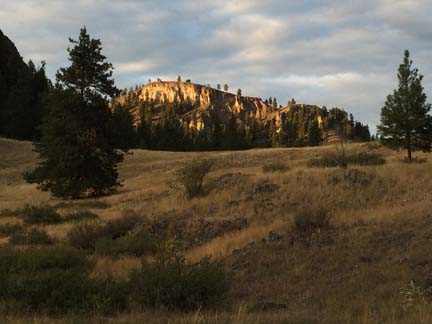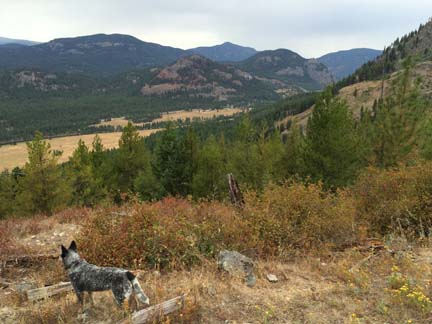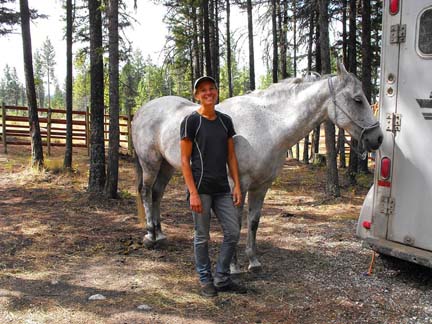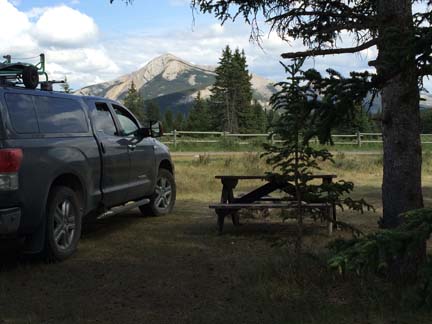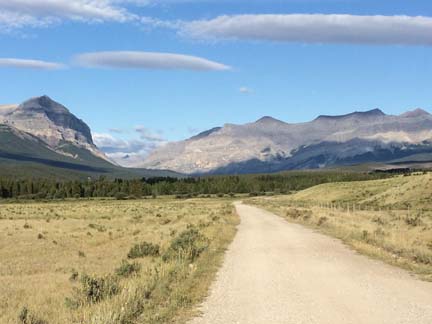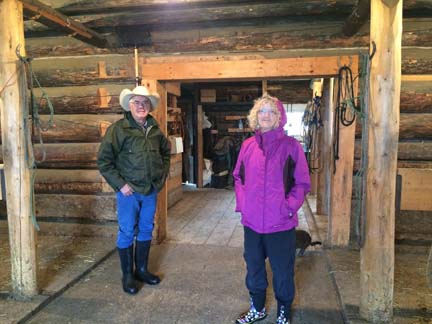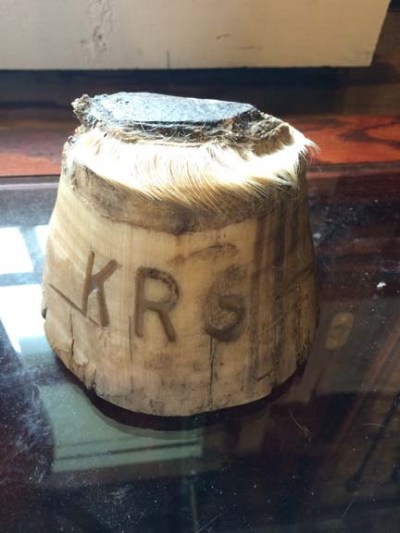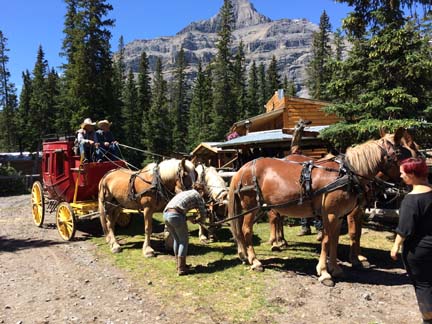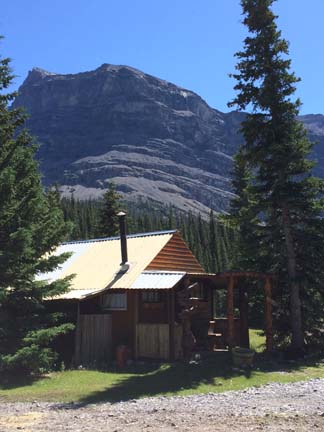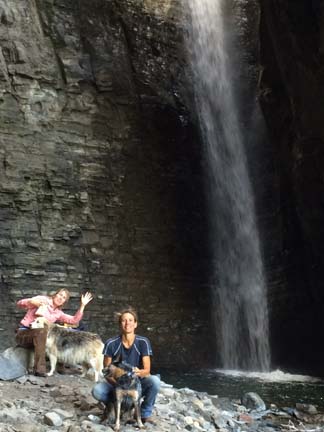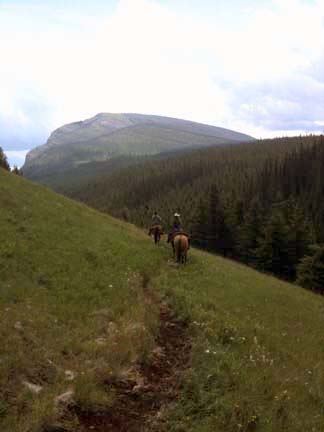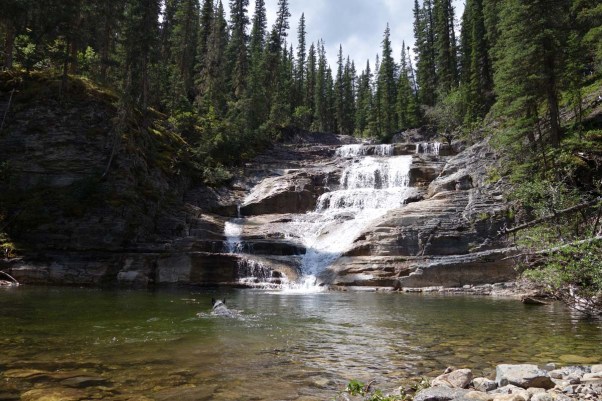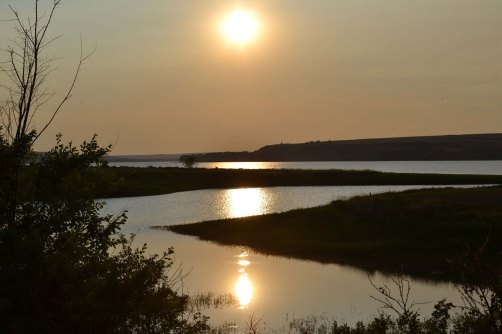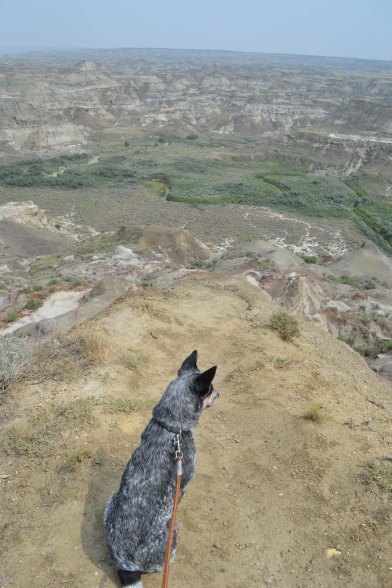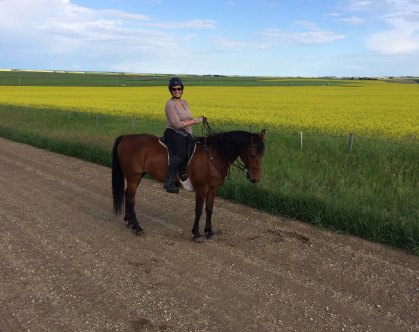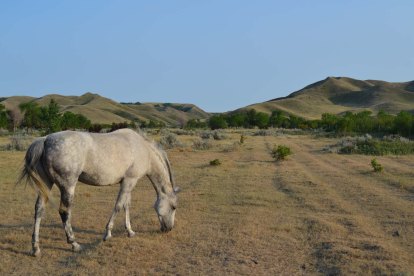It’s a measure of my level of chilled-out-ness after six weeks of travel that when I left Ya Ha Tinda on Wednesday morning, I still did not know where I would be spending the night – hitting the road with that kind of uncertainty is not at all consistent with my control-freak personality. Not knowing where I’d be laying my head (and my horse’s head) for the night meant I also did not know which route I’d be taking home – through Kicking Horse and Rogers Pass to Golden and Salmon Arm, or through Kootenay Pass to Invermere and Oliver? I was hoping to take the latter route, since I’d heard good things about the riding in Rock Creek, near Oliver.
After driving southeast, chasing that morning’s furious thunderstorm with its attendant hail and rain, we hit Cochrane, and I paused to do some web searching and phoning around. One of the last places I called, on the suggestion of an outfitter I thought was local but who was in Alberta when I called his cell because he’d pulled up stakes and moved, was the trail riding stable at Fairmont Hot Springs. I got ahold of Brent, who was completely accommodating. “Oh sure,” he said. “There’s a paddock off to the side you can use.” No problem.
So the southern route it was.
The girls at the stable told me I could just park my rig at the stable and camp there – and a very scenic campsite indeed it would have been – but I was hankering for a hot shower. I opted for the campground at the resort, and was assigned a site that was within walking distance of the stable.
Unlike a lot of campground showers, which feature little buttons that you push and which let out a sad trickle of lukewarm water for 30 seconds until you push the button again, the showers at Fairmont have real faucets with unlimited water. The controls start at “hot” (read, “scalding”), progress to “warm” (read, “very, very hot”), and finally dial over to “cool” (read, “normal temperature for people who like hot showers”). I may be making this up, but I’m going to say that being a hot springs sorta place, they actually need to add cold water to their hot water, rather than vice versa. Given that it had been a month since I’d had a real shower (i.e. not in a camper and not out of a bag), I went crazy. I must have spent 20-30 minutes in that shower (it was early. No one else was up).
I’d have liked to have stayed and ridden some of the trails at Fairmont, because the area looked gorgeous and I bet the trails were awesome, but I wanted to spend my few remaining days exploring the Southern Interior, country I had not yet experienced. The next morning, off we headed to Rock Creek, which is an hour or so west of Oliver.
My camping destination for the next night or two was the equestrian campground adjacent to the Rock Creek fairgrounds. Unfortunately, the “people” campground was closed for the weekend for a private function, which meant that the equestrian campground was also closed. Jodi, the fairgrounds contact person, said it would be OK to take a stall at the grounds, and camp there, so that’s what I opted to do. I set Pai up in a comfy corner stall, and parked directly in front of her, which allowed me to make use of a nearby power source to keep my sketchily-wired fridge charged (I’d given up on storing food in the fridge long ago, and was now using it solely to keep beverages cool), and recharge my laptop (my camper inverter was likewise on the fritz).
I took Pai out for a short, 45-minute “stretch your legs” ride in the evening once the air cooled down a bit, and then cooked myself a dinner of cedar-planked salmon, and then spent the tail of the evening quaffing wine on the porch with the delightful Mel, who is the on-site fairgrounds camp operator. Mel is a former competitive vaulter from Germany, and now trains horses and teaches vaulting to local kids. We chatted and sipped wine into the evening, while her kids camped out in a tent in her back yard.
Since there were no maps in sight at the trailhead, Mel pulled out a big poster from a previous endurance ride that had been held there a few years prior, and I took six pictures of it with my phone as a fun, “guess which trail connects to which” puzzle. (And then Spy turned the map into a real puzzle when I had my back turned, and I found him in a pile of poster confetti. I spent 20 minutes before my ride duct taping the back of the pieces back into some semblance of a map). The pics did help me orient myself for my ride the next day, but since I have mad skillz when it comes to getting lost, I got lost.
The Kettle River Trails depart from the fairgrounds and spread north in loops of various distances. I managed to get off track somewhere around 10 km onto the trail, when I decided that I probably was on the Guard Trail, but, clearly, wasn’t. I’ve got a stubborn determination to ride loops rather than out-and-backs, so, even when I know I can get back to where I came from by retracing my path, I tend to choose to press onward, hoping to find that elusive loop home. As I texted Mr Andrews, “I know where I came from. I just don’t know where I’m going.”
The Kettle River runs through Rock Creek, and it is surrounded by high terrain that varies vastly in its vegetation, from sage-clad dry grass hills with a few cactus and the odd rattlesnake, to open forest of red-trunked Ponderosa pine on grass, to more dense forest of fir and brushy undergrowth.
My ride ended up taking longer than I’d planned, and I came home via a quiet road rather than on the trail I thought I’d end up on, but it all worked out OK. I figure we rode somewhere between 20 and 30 km. I spoke to local gal Jenny, who knows the trails well, and she reckoned I’d gotten a pretty good taste of what the area offers.
Despite having had a pretty decent ride on some lovely trails, at 4 pm, after untacking and cleaning up my horse and getting her fed, I decided that my make-do fairgrounds “camp” parked within earshot of Hwy 3 just wasn’t doing it for me as a way to wind up my trip. After flipping through my notes for possible alternatives, and then and firmly deciding it was more sensible to just stay put at the fairgrounds, I picked up the phone and called Hideaway Horse Camp in Oliver. The camp owner was charming and welcoming on the phone, and said I’d have the camp to myself. Sold!
The only other place I’ve seen one of these wildlife signs was near 108 Mile in the Cariboo.
They have wild horses around Oliver, too, and I saw a herd of healthy-looking mares and foals on my way in to Hideaway.
Hideaway Horse Camp ended up being just a perfect way to end my travels. The camp belongs to Anna-Maria and Larry Robinson, and its four campsites and roomy corrals are set on a treed hillside adjacent to Crown Land. Anna-Maria is a great host with a knack for making guests comfortable. We gabbed for a couple of hours after dinner on Friday night, and, on Saturday morning, as the night’s drizzle started to clear, she sent me off on the trails with a couple of (delicious) homemade banana-peanut butter granola bars.
Anna-Maria has put a lot of effort into mapping and marking the trails well, but I still managed to lose the plot on my Saturday morning ride. I’m really, really good at leaving the tour. I didn’t snap any pics on my ride along wide, grassy and sandy trails, since the day was misty and the views were barely discernable behind cloud. I know they’re there, though! Someday, I’d like to come back and see them for real.
We left Hideaway at noon, and hit Horseshoe Bay in time to catch an evening ferry back to the Island.
As I drove into the barn yard, where Mr Wayde Andrews was waiting for me, it seemed like I’d set out on my trip a year ago. And yet it seemed like I’d only left an hour ago.
It took six hours, the next day, to clean out my truck and trailer. In six hours, over six weeks on the road were erased, and it looked as though I’d never gone anywhere at all.
Camp and trail notes for horsey folk:
1. Fairmont Hot Springs Resort
Fairmont has hiking trails and trails that are used by the trail riding crew. I don’t know how often they are asked to board horses, but Brent was very accommodating, and it looks like it would be a fine place to camp and ride for a few days. Stabling in a roomy paddock was $15 (unofficial price); camping fees range from $30 for un-powered to $65 for deluxe powered. The stable is less than 1 km from the campground, an easy walk.
As an aside, the Dry Gulch Provincial Park also agreed to house me and my horse for the night. They are located right alongside the highway, so it would make me a little leery to Hi Tie or use an e-corral there, but there it is as an option. As I drove by, I noted that there’s a big stable next door – a person could probably check out their receptiveness to overnight board, and then camp at Dry Gulch.
2. Rock Creek/Kettle River Trails
The Rock Creek Fairgrounds has a sign denoting the “wilderness” equestrian campsite. A more accurate term would probably be “wilderness-style”, since the campground is alongside a roadway and Hwy 3 roars by right across the river and doesn’t really hit the specs for “wildnerness”. It is, however, a minimal-facility campsite, which makes it kind of wilderness-y, with trees for high-lining on its nice, large, very level grounds; pit toilets; and water (somewhere – I didn’t see it, but it’s there somewhere). The “people” campsite across the road has showers and laundry. Camping is $12. You can also rent a stall at the fairgrounds proper, a few hundred metres down the road, for $20. There are no toilet facilities at the fairgrounds, but there is water.
There is no map at the trailhead, and no paper maps available when I was there, but after talking to Jenny, I think the fairgrounds folks will be supplying Mel with a stack of maps to hand out to riders, which will be awesome.
The trails have some sustained climbs, and some level riding once you reach the top. There are some lakes back there (I was headed for them, until I lost the plot). The footing, mostly along wide lane-like trails, is lovely. There are views here and there of the surrounding mountains and Kettle River.
3. Hideaway Horse Camp
Hideaway has four campsites with double-sized corrals in a gorgeous setting among the trees. There’s a cooking hut/shelter, an swank cowboy shower with stone flooring, and the World’s Most Uptown Outhouse. Seriously. You could just hang out in that outhouse.
Cost is $5 per horse and $10 per person.
Trails are well-mapped and well-marked. I only rode for a couple of hours, but you could spend a few days riding trails there. The footing is fantastic, and trails vary from wide grassy lanes to single track through the trees (and if, like me, you get lost and follow wild horse trails instead of the real trails, you do a lot of single track through the trees!). I didn’t make it to the little lake/reservoir, and I didn’t get to see what look like would be awesome views over the valley – I’ll have to go back sometime!


